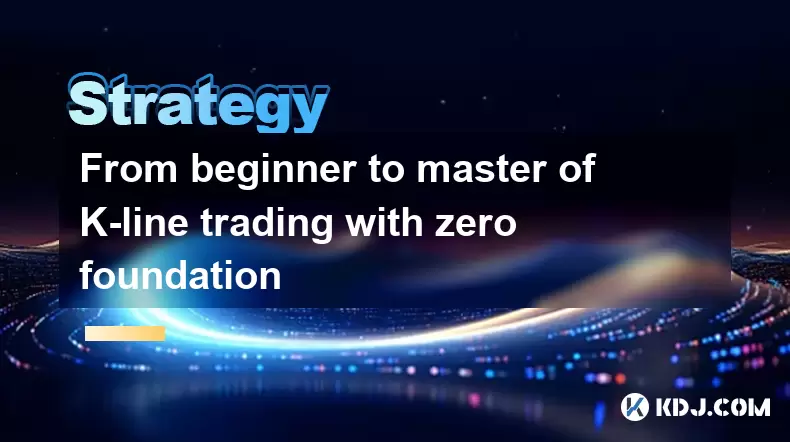-
 bitcoin
bitcoin $123963.239194 USD
1.37% -
 ethereum
ethereum $4529.082464 USD
1.07% -
 xrp
xrp $2.983640 USD
0.71% -
 tether
tether $1.000287 USD
0.02% -
 bnb
bnb $1179.874393 USD
2.99% -
 solana
solana $230.633678 USD
1.55% -
 usd-coin
usd-coin $0.999835 USD
0.03% -
 dogecoin
dogecoin $0.254240 USD
1.34% -
 tron
tron $0.341176 USD
0.15% -
 cardano
cardano $0.842285 USD
0.52% -
 hyperliquid
hyperliquid $48.537896 USD
-0.86% -
 chainlink
chainlink $21.863092 USD
-0.84% -
 ethena-usde
ethena-usde $0.999743 USD
-0.07% -
 sui
sui $3.579561 USD
-0.18% -
 stellar
stellar $0.403418 USD
2.67%
From beginner to master of K-line trading with zero foundation
From novice to expert, mastering K-line trading involves learning basics, recognizing patterns, using advanced techniques, and applying practical strategies while managing risks.
Jun 07, 2025 at 08:28 am

From beginner to master of K-line trading with zero foundation, the journey involves understanding the basics, progressing to advanced strategies, and constantly refining your skills. K-line charts, also known as candlestick charts, are a fundamental tool in cryptocurrency trading. They provide a visual representation of price movements over a specific period, enabling traders to make informed decisions. This article will guide you through the essential steps and knowledge required to become proficient in K-line trading.
Understanding the Basics of K-Line Charts
K-line charts are crucial for anyone venturing into cryptocurrency trading. Each K-line represents the price movement of an asset within a specific timeframe, typically ranging from one minute to one day. A K-line consists of a body and two wicks (or shadows). The body shows the opening and closing prices, while the wicks indicate the highest and lowest prices during that period.
- Bullish K-line: When the closing price is higher than the opening price, the body is usually colored green or white, indicating a price increase.
- Bearish K-line: If the closing price is lower than the opening price, the body is typically colored red or black, signaling a price decrease.
Understanding these basics allows you to interpret the market sentiment and make initial trading decisions.
Learning Common K-Line Patterns
As you progress in your trading journey, recognizing common K-line patterns becomes essential. These patterns can signal potential market movements and help you make more accurate predictions.
- Doji: A Doji is a K-line where the opening and closing prices are virtually the same, resulting in a very small or non-existent body. It suggests market indecision and can signal a potential reversal.
- Hammer and Hanging Man: Both patterns have small bodies and long lower wicks. A Hammer at the bottom of a downtrend can indicate a bullish reversal, while a Hanging Man at the top of an uptrend may signal a bearish reversal.
- Engulfing Patterns: These occur when a larger K-line completely engulfs the previous smaller K-line. A bullish engulfing pattern suggests a potential upward trend, while a bearish engulfing pattern indicates a possible downward trend.
Mastering these patterns requires practice and observation, but they are crucial for intermediate traders.
Advanced K-Line Analysis Techniques
To transition from an intermediate to an advanced trader, you must delve into more complex K-line analysis techniques. These include combining multiple patterns, using indicators, and understanding market psychology.
- Combining Patterns: Advanced traders often look for sequences of patterns to confirm their predictions. For instance, a Doji followed by a bullish engulfing pattern can be a strong signal for a bullish reversal.
- Technical Indicators: Tools like the Moving Average Convergence Divergence (MACD), Relative Strength Index (RSI), and Bollinger Bands can complement K-line analysis. They help validate the signals provided by K-line patterns.
- Market Psychology: Understanding the emotions and behaviors driving market movements can enhance your K-line analysis. For example, recognizing fear and greed can help you predict potential market reversals.
By integrating these advanced techniques, you can significantly improve your trading accuracy and profitability.
Practical Trading Strategies Using K-Line Analysis
Developing effective trading strategies based on K-line analysis is a key step towards mastery. Here are some practical strategies you can implement:
- Trend Following: Identify the overall trend using K-line patterns and indicators. Enter trades in the direction of the trend, using patterns like bullish engulfing or bearish engulfing to confirm entry points.
- Breakout Trading: Look for K-lines that break through key resistance or support levels. A strong K-line breaking above resistance can signal a buying opportunity, while a K-line breaking below support may indicate a selling opportunity.
- Reversal Trading: Use reversal patterns like Doji, Hammer, and Hanging Man to anticipate market reversals. Combine these with indicators like the RSI to increase the accuracy of your predictions.
Implementing these strategies requires discipline and patience, but they can lead to consistent trading success.
Risk Management and Continuous Learning
Mastering K-line trading is not just about understanding charts and patterns; it also involves effective risk management and continuous learning. Here are some essential tips:
- Set Stop-Loss Orders: Always use stop-loss orders to limit potential losses. Determine your stop-loss levels based on your analysis of K-line patterns and market trends.
- Position Sizing: Manage your trade sizes to ensure that no single trade can significantly impact your overall portfolio. Use a percentage of your total capital for each trade, based on your risk tolerance.
- Continuous Learning: The cryptocurrency market is dynamic, and new patterns and strategies emerge regularly. Stay updated with market news, participate in trading communities, and continuously refine your skills.
By adhering to these principles, you can safeguard your capital and enhance your trading proficiency.
Frequently Asked Questions
Q: How can I practice K-line trading without risking real money?A: You can use demo accounts offered by many cryptocurrency exchanges and trading platforms. These allow you to trade with virtual money, enabling you to practice K-line analysis and develop strategies without financial risk.
Q: Are there any tools or software that can help with K-line analysis?A: Yes, several tools and software can assist with K-line analysis. TradingView is a popular platform that offers advanced charting tools and indicators. Additionally, many cryptocurrency exchanges have built-in charting features that you can use for analysis.
Q: How important is it to combine K-line analysis with other forms of analysis?A: Combining K-line analysis with other forms of analysis, such as fundamental analysis and sentiment analysis, can provide a more comprehensive view of the market. While K-line analysis is powerful, integrating it with other methods can enhance your trading decisions.
Q: Can K-line patterns be used for short-term and long-term trading?A: Yes, K-line patterns can be used for both short-term and long-term trading. The key is to adjust the timeframe of your K-line charts. For short-term trading, use shorter timeframes like one-minute or five-minute charts. For long-term trading, use daily or weekly charts to identify broader trends and patterns.
Disclaimer:info@kdj.com
The information provided is not trading advice. kdj.com does not assume any responsibility for any investments made based on the information provided in this article. Cryptocurrencies are highly volatile and it is highly recommended that you invest with caution after thorough research!
If you believe that the content used on this website infringes your copyright, please contact us immediately (info@kdj.com) and we will delete it promptly.
- BlockDAG, DOGE, HYPE Sponsorship: Crypto Trends Shaping 2025
- 2025-10-01 00:25:13
- Deutsche Börse and Circle: A StableCoin Adoption Powerhouse in Europe
- 2025-10-01 00:25:13
- BlockDAG's Presale Buzz: Is It the Crypto to Watch in October 2025?
- 2025-10-01 00:30:13
- Bitcoin, Crypto, and IQ: When Genius Meets Digital Gold?
- 2025-10-01 00:30:13
- Stablecoins, American Innovation, and Wallet Tokens: The Next Frontier
- 2025-10-01 00:35:12
- NBU, Coins, and Crypto in Ukraine: A New Yorker's Take
- 2025-10-01 00:45:14
Related knowledge

Practical parameter settings for a Bitcoin multi-timeframe moving average system
Sep 18,2025 at 10:54pm
Optimizing Timeframe Combinations for Bitcoin Trading1. Selecting appropriate timeframes is crucial when building a multi-timeframe moving average sys...

How can I filter out false breakouts in Dogecoin high-frequency trading?
Sep 22,2025 at 01:00am
Understanding False Breakouts in Dogecoin Trading1. A false breakout occurs when Dogecoin's price appears to move beyond a defined support or resistan...

Techniques for identifying tops and bottoms in the Bitcoin on-chain NVT model
Sep 20,2025 at 07:54pm
Understanding the NVT Model in Bitcoin Analysis1. The Network Value to Transactions (NVT) ratio is often described as the 'P/E ratio' of the cryptocur...

What does the surge in open interest in Bitcoincoin futures mean?
Sep 20,2025 at 11:18pm
Understanding the Surge in Dogecoin Futures Open Interest1. A surge in open interest within Dogecoin futures indicates a growing number of active cont...

How can I use the Ethereum USDT premium to gauge market sentiment?
Sep 18,2025 at 11:55pm
Understanding the Ethereum USDT Premium1. The Ethereum USDT premium refers to the price difference between USDT (Tether) traded on Ethereum-based plat...

What should I do if Ethereum staking yields decline?
Sep 20,2025 at 06:18am
Understanding the Causes Behind Declining Ethereum Staking Yields1. The Ethereum network transitioned to a proof-of-stake consensus mechanism with the...

Practical parameter settings for a Bitcoin multi-timeframe moving average system
Sep 18,2025 at 10:54pm
Optimizing Timeframe Combinations for Bitcoin Trading1. Selecting appropriate timeframes is crucial when building a multi-timeframe moving average sys...

How can I filter out false breakouts in Dogecoin high-frequency trading?
Sep 22,2025 at 01:00am
Understanding False Breakouts in Dogecoin Trading1. A false breakout occurs when Dogecoin's price appears to move beyond a defined support or resistan...

Techniques for identifying tops and bottoms in the Bitcoin on-chain NVT model
Sep 20,2025 at 07:54pm
Understanding the NVT Model in Bitcoin Analysis1. The Network Value to Transactions (NVT) ratio is often described as the 'P/E ratio' of the cryptocur...

What does the surge in open interest in Bitcoincoin futures mean?
Sep 20,2025 at 11:18pm
Understanding the Surge in Dogecoin Futures Open Interest1. A surge in open interest within Dogecoin futures indicates a growing number of active cont...

How can I use the Ethereum USDT premium to gauge market sentiment?
Sep 18,2025 at 11:55pm
Understanding the Ethereum USDT Premium1. The Ethereum USDT premium refers to the price difference between USDT (Tether) traded on Ethereum-based plat...

What should I do if Ethereum staking yields decline?
Sep 20,2025 at 06:18am
Understanding the Causes Behind Declining Ethereum Staking Yields1. The Ethereum network transitioned to a proof-of-stake consensus mechanism with the...
See all articles










































































